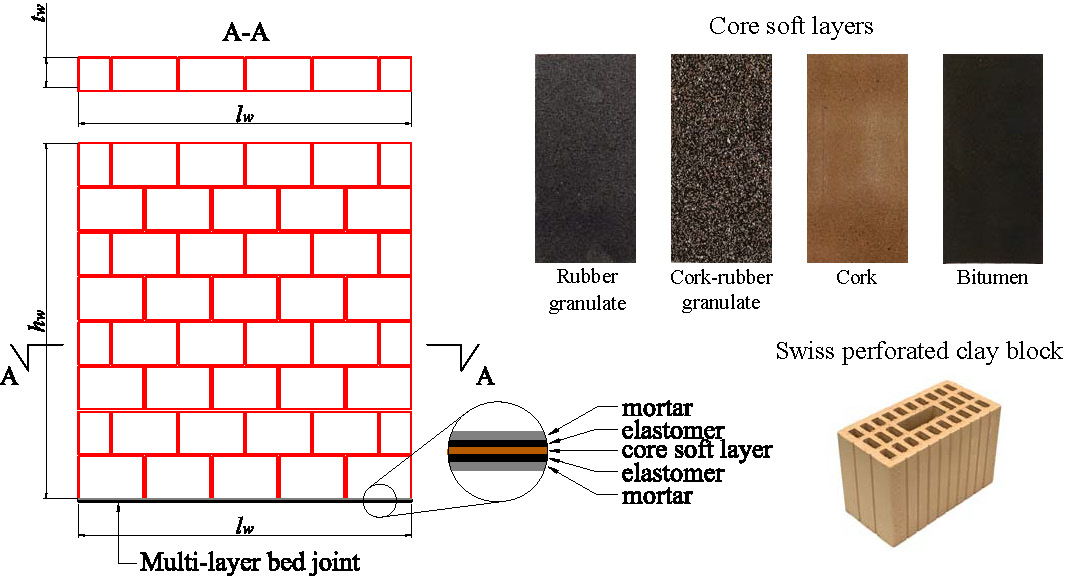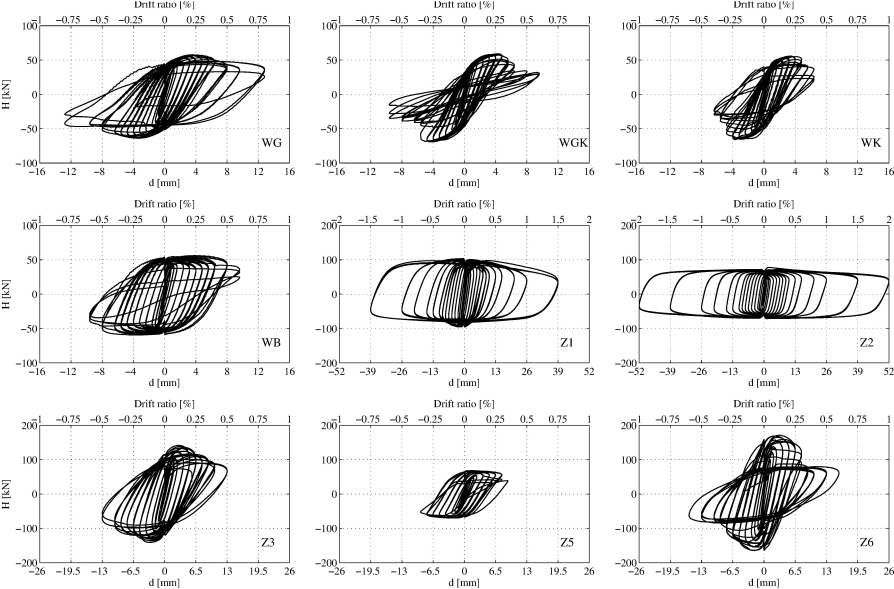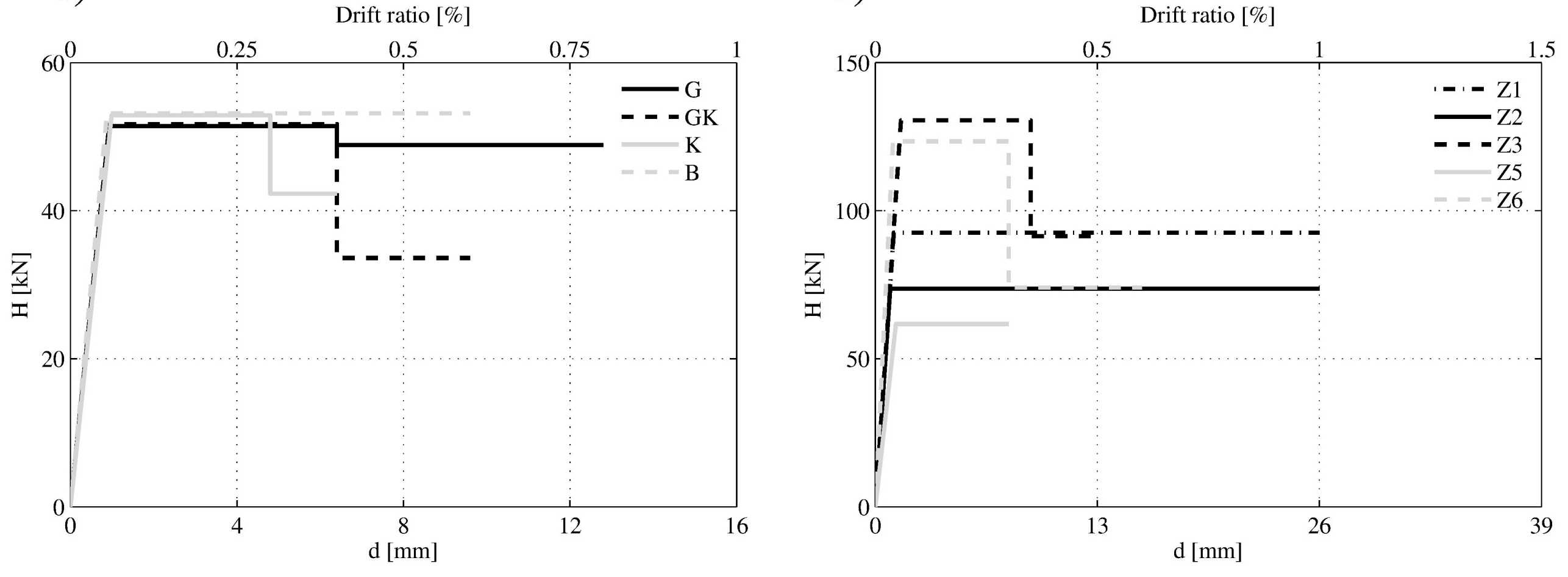Development of a Soft Layer for Seismic Response Modification of Structural Masonry Walls
This project is about engineering a seismic response modification technology for structural masonry walls that will maximize the seismic performance benefits at minimum cost and minimum change in the current construction practices. The fundamental idea is to place engineered deformable layers at the bottom and the top of a masonry structural wall. Such layers are already placed for moisture insulation and sound isolation (at the bottom) and to allow for floor slab deflection (at the top of the wall). The goal of this project is to engineer the mechanical properties of the “soft” layers such that the structural masonry wall with such “soft” layers responds in three different regimes:
- an initial essentially elastic regime, with relatively high stiffness;
- a sliding regime, with relatively low stiffness, capped horizontal shear force, and stable hysteresis under repeated cycling; and
- a conventional shear regime, engaged when the wall engages the sliding limits of the “soft” layer, with relatively high stiffness and increasing horizontal shear resistance until shear failure.
The wall is expected to carry its tributary gravity load until its shear failure. The preliminary work by the project investigators and other researchers suggests that it is possible to achieve this goal. Structural masonry wall with such engineered “soft” layers will enable the masonry structure to achieve the following performance goals:
- experience essentially no damage in frequent earthquakes and under high wind loads when the structure is expected to remain elastic;
- experience controlled damage while preserving the gravity load-carrying capacity in design-basis earthquakes through controlled lateral sliding deformation and an elongation of the structural response period due to low stiffness in the sliding regime; and
- collapse prevention in beyond-design-basis earthquakes through engagement of the full shear strength of the structural masonry walls.
The engineering of the “soft” layer in terms of its friction coefficient and deformation capacity will be done to enable achieving these performance goals in regions of low and moderate seismicity.
The research project is funded by external page Swiss National Science Foundation (SNF) and will be conducted together with Prof. Dr. Bozidar Stojadinovic (Chair of Structural Dynamic and Earthquake Engineering) of our Institute.
Results from the preliminary research on masonry elements with rubber granulate and elastomer soft layers indicated that the presence of such layers in the mortar bed joint can significantly alter the mechanical characteristics of URM walls by creating a sliding plane, which, in turn, could influence the seismic response of the entire structure. An extensive experimental programm on small masonry elelents (triplets) as well as on the wallettes (1.2x1.2m) has been conducted. The results and discussion is presented in following publications:
- N. Mojsilović, B. Stojadinovic, A. Barandun and C. Vögeli: "Seismic behavior of masonry walls with soft-layer wall bearings", Proceedings, 5th International Conference on Structural Engineering, Mechanics and Computation, Cape Town, South Africa, September 2-4, 2013, pp. 1865-1870.
- N. Mojsilović and B. Stojadinović: "Development of a Soft Layer for Seismic Response Modification of Structural Masonry Walls", Proceedings, 10th US National Conference on Earthquake Engineering, Earthquake Engineering Research Institute, Anchorage, Alaska, July 21-25, 2014. DOI:10.4231/D3ZC7RV31
- M. Petrović, N. Mojsilović and B. Stojadinović: "Use of Soft Layers to Modify the Response of Masonry Structures: State-Of-The-Art Review", Proceedings, 12th North American Masonry Conference, Denver, Colorado, May 17-20, 2015.
- Vögeli C., Mojsilović N. and Stojadinovic B.: "external page Masonry wallettes with a soft layer bed joint: Behaviour under static-cyclic loading", Engineering Structures, 86, 2015, pp. 16-32.
- M. Petrović, B. Stojadinović and N. Mojsilović: "Static-cyclic tests on I-shaped masonry wallettes with soft layer bed joint", Proceedings, 16th International Brick/Block Masonry Conference, Padova, Italy, June 26-30, 2016, pp. 1807-1813.
- N. Mojsilović, M. Petrović and R. Büchler: "Compressive strength of masonry with soft layers in bed joint", Proceedings, 6th International Conference on Structural Engineering, Mechanics and Computation, Cape Town, South Africa, September 5-7, 2016, pp. 1691-1696.
- Petrović M., Stojadinović B. and Mojsilović N.: "external page I-shaped unreinforced masonry wallettes with a soft layer bed joint: Behaviour under static-cyclic shear", ASCE Journal of Structural Engineering, 143 (11), 2017.
Rubber granulate soft layers were in some cases heavily damaged during the sliding, whereas the elastomer layers were found to be significantly more durable. In order to improve the joint behaviour a multi-layer bed joint has been introduced and several series of monotonic and quasi-static cyclic, displacement controlled tests were performed on masonry triplets with such joint. The so-called multi-layer bed joint consisted of a core soft layer (rubber granulate, cork, cork-rubber granulate, bitumen and PVC based membranes were used) which, in order to reduce the damage caused by cyclic loading, was protected by two layers of elastomer, and placed in the middle of the mortar bed joint. Results indicated that multi-layer bed joints with adequate material properties could change the typical brittle shear response of masonry to a more desirable quasi-ductile one. Further, based on the observed hysteretic behaviour, considerable energy dissipation can be achieved in masonry structures with multi-layer bed joints. Figure below shows the structure of the multi-layer bed joint.
The results of this experimental work are presented in detail in following publications:
- M. Petrović, X.R. Anglada, and N. Mojsilović: "Shear Tests on Masonry Elements with Soft Layer in Bed Joint", Proceedings, 12th North American Masonry Conference, Denver, Colorado, May 17-20, 2015.
- Mojsilović N., Petrović M. and Anglada X.R.: "external page Masonry elements with multi-layer bed joints: Behaviour under monotonic and static-cyclic shear", Construction and Building Materials, 100, 2015, pp. 149-162.
Subsequently, an analytical model for the multi-layer bed joint has been proposed. The shear load-deformation behaviour of a multi-layer bed joint is as assumed linear elastic-perfectly viscoplastic. Such behaviour can be captured by a uniaxial model consisting of three elements: an elastic spring, ES, connected in series with a frictional slider, FS, and a dashpot, VD, (viscous damper), see figure below. Thereby the elastic spring is characterized by the shear modulus of the multi-layer bed joint, the dashpot by the loading speed sensitive viscosity parameter with the dimension time and the frictional slider by the elastic shear stress limit, i.e. sliding resistance.
The model is capable of capturing of the loading-speed dependent in-plane shear load-slip behaviour, which is thus assumed to be linear elastic-perfectly viscoplastic. Although the model parameters are determined for the multi-layer bed joint with a rubber granulate core soft layer, the parameter space can be extended to other types of core soft layer once the appropriate test data becomes available. Detailed description of the model is provided in:
Mojsilović N., Petrović M. and Stojadinović B.: "external page Multi-layer masonry bed joint subjected to shear: Analytical modelling", Construction and Building Materials, 205C, 2019, pp. 602-610.
A series of static-cyclic shear tests on full-scale unreinforced masonry (URM) walls with multi-layer bed joints have been performed within this project to deepen the insight on the seismic behaviour of unreinforced masonry walls with soft layer membrane placed in the bed joint. Walls were made using typical perforated Swiss clay blocks and standard cement mortar and the multi-layer bottom bed joints. The preliminary testing phase was aimed at choosing the most suitable core soft layer type among the four types considered (rubber granulate, cork, cork-rubber granulate and bitumen). The main testing phase comprised five tests on storey-high URM specimens with rubber granulate core soft layers performed to investigate the influence of the size, the pre‐compression level and the aspect ratio on the seismic behaviour of URM walls with a multi‐layer bed joint. Sliding occurred in all tested specimens. However, the final failure mode as well as the displacement capacity of test specimens were governed by the extent of shear and tensile (vertical) cracks that developed from the bottom brick course. In the figure below a response of the specimens is shown.
All specimens with a rubber granulate core soft layer responded in the same manner, i.e. the initial shear deformation of the core soft layer was followed by sliding along the core soft layer. Thus, the horizontal force resistance can be predicted adequately using the Mohr-Coulomb friction law. Based on the presented test results, an apparent friction coefficient of 0.2 and the corresponding apparent cohesion of 0.15 MPa, are recommended to estimate the horizontal force resistance of full-scale URM walls with rubber granulate multi-layer bed joints. Further, an equation for calculating the initial elastic stiffness, which considers the shear deformation of the multi-layer bed joint as well the influence of the wall pre-compression, is proposed. The extent of shear cracks developed in the wall as well as the appearance of (vertical) tensile cracks, which reduced the effective area of the walls, strongly influenced the failure mode and the ultimate displacement capacity of the tested walls.
Further, a method to construct an idealization of the horizontal force-displacement response envelope for the tested URM walls with multi-layer bed joints is proposed. The parameters of this envelope are defined by analogy to the response envelope proposed in FEMA-356 to capture the strength, stiffness and ultimate displacement capacity of the walls, as well as to model sudden drops in wall horizontal force resistance if they occur, see figure below.
The results of this experimental work are presented in detail in following publications:
- M. Petrović, N. Mojsilović and B. Stojadinović: "Masonry walls with a multi-layer bottom bed joint: Behavior under static-cyclic shear", Proceedings, 11th PhD International Symposium in Civil Engineering, Tokyo, Japan, August 27-29, 2016, pp. 687-694.
- Petrović M., Mojsilović N. and Stojadinović B.: "external page Masonry walls with a multi-layer bed joint subjected to in-plane cyclic loading: An experimental investigation", Engineering Structures, 143C, 2017, pp. 189-203.
- N. Mojsilović, M. Petrović and B. Stojadinović: "Influence of the Multi-Layer Bed Joint on the Crack Distribution in Masonry Walls Subjected to Static-Cyclic Loading", Proceedings, 13th North American Masonry Conference, Salt Lake City, Utah, June 16-19, 2019, pp. 459-470.
Finally, an analytical rheological model capable of describing the loading speed dependent in-plane shear behavior of the unreinforced masonry walls with a multi-layer bed joint subjected to static-cyclic shear loading is introduced. Joint behavior is assumed to be linear elastic-perfectly visco-plastic as described above. Further, assuming a linear elastic behavior of masonry, the joint model has been extended and was able to describe the in-plane horizontal force-displacement behavior of URM walls with multi-layer bottom bed joints and was validated against the experimental results. However, possible separation of the wall into more parts, initiated by the tensile cracks in head joints at the bottom block course, which can lead to significant strength and stiffness degradation of the wall, and/or exceeding of the limit of the elastic masonry de-formation, limits the model applicability.
It was shown that, using the proposed model, for the given loading speed and horizontal displacement the force resistance of URM walls with a rubber granulate core soft layer in the multi-layer bed joint can be predicted well. Moreover, using the proposed model, the in-plane horizontal force-displacement behavior has been described with satisfactory accuracy. In the figure below, the comparison with experimental results for walls Z1 and Z2 is shown.
Detailed description of the model is given in:
N. Mojsilović, M. Petrović and B. Stojadinović: "Masonry walls with multi-layer bed joints subjected to cyclic shear: Analytical modelling", Proceedings, 17th International Brick/Block Masonry Conference, Krakow, Poland, July 5-8, 2020, pp. 687-693.
Summarizing the project findings it can be said that the presence of a multi-layer bed joint with a rubber granulate core soft layer results in relatively soft response of URM walls, i.e. leads to an elongation of the initial fundamental vibration period of URM structures that contain such multi-layer bed joints. Further, the multi-layer bed joints can allow for a remarkable amount of plastic deformation (given their thickness) before the onset of shear failure (if any) of the masonry, making their response quasi-ductile. Therefore, multi-layer bed joints in URM walls act to modify the dynamic response of structures and improve their seismic performance. The displacement capacities of URM walls with multi-layer bed joints are, however, relatively small, making this response modification approach suitable for regions of low and moderate seismicity.
This project has been completed.




